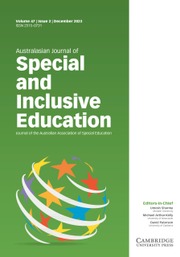Crossref Citations
This article has been cited by the following publications. This list is generated based on data provided by
Crossref.
Kennedy, Emma‐Kate
and
Laverick, Laleh
2019.
Leading Inclusion in Complex Systems: experiences of relational supervision for headteachers.
Support for Learning,
Vol. 34,
Issue. 4,
p.
443.
Anderson, Joanna
and
Boyle, Christopher
2019.
Looking in the mirror: reflecting on 25 years of inclusive education in Australia.
International Journal of Inclusive Education,
Vol. 23,
Issue. 7-8,
p.
796.
Carter, Susan
2020.
Inclusive Theory and Practice in Special Education.
p.
301.
DeMatthews, David
2020.
Undoing systems of exclusion: exploring inclusive leadership and systems thinking in two inclusive elementary schools.
Journal of Educational Administration,
Vol. 59,
Issue. 1,
p.
5.
DeMatthews, David
Billingsley, Bonnie
McLeskey, James
and
Sharma, Umesh
2020.
Principal leadership for students with disabilities in effective inclusive schools.
Journal of Educational Administration,
Vol. 58,
Issue. 5,
p.
539.
Jang, Jeong-Hun
and
Ha, Kyoo-Man
2021.
Inclusion of Children with Disabilities in Disaster Management.
Children,
Vol. 8,
Issue. 7,
p.
581.
Quick, Tracey
Flatley, Beth
Sellwood, Claire
Alam, Oishee
and
Vukovich, Ildi
2021.
A Model of Inclusion for Children With Disability in NSW Community Preschools.
Australasian Journal of Special and Inclusive Education,
Vol. 45,
Issue. 2,
p.
150.
Guo-Brennan, Linyuan
and
Guo-Brennan, Michael
2021.
Leading Welcoming and Inclusive Schools for Newcomer Students: A Conceptual Framework.
Leadership and Policy in Schools,
Vol. 20,
Issue. 1,
p.
57.
Duncan, Jill
and
Punch, Renee
2021.
Building Inclusive Education Workforce Capability: School Principals’ Perceptions of Roles and Responsibilities.
Australasian Journal of Special and Inclusive Education,
Vol. 45,
Issue. 1,
p.
62.
Kivirand, Tiina
Leijen, Äli
Lepp, Liina
and
Tammemäe, Tiiu
2021.
Designing and Implementing an In-Service Training Course for School Teams on Inclusive Education: Reflections from Participants.
Education Sciences,
Vol. 11,
Issue. 4,
p.
166.
Kivirand, Tiina
Leijen, Äli
and
Lepp, Liina
2022.
Enhancing Schools’ Development Activities on Inclusive Education Through In-service Training Course for School Teams: A Case Study.
Frontiers in Psychology,
Vol. 13,
Issue. ,
Carter, Mark
Webster, Amanda
Stephenson, Jennifer
Waddy, Neale
Stevens, Robert
Clements, Melissa
and
Morris, Talia
2022.
Decision-making regarding adjustments for students with special educational needs in mainstream classrooms.
Research Papers in Education,
Vol. 37,
Issue. 5,
p.
729.
Gómez-Hurtado, Inmaculada Gómez
González-Falcón, Inmaculada
García-Rodríguez, María del Pilar
and
Coronel-Llamas, Jose Manuel
2022.
Instilling Diversity and Social Inclusion Practices in Teacher Education and Curriculum Development.
p.
113.
Agbenyega, Joseph Seyram
and
Klibthong, Sunanta
2022.
Giving voice: inclusive early childhood teachers’ perspectives about their school leaders’ leadership practices.
International Journal of Leadership in Education,
p.
1.
Stephenson, Jennifer
and
Ganguly, Rahul
2022.
Analysis and Critique of the Advocacy Paper Towards Inclusive Education: A Necessary Process of Transformation.
Australasian Journal of Special and Inclusive Education,
Vol. 46,
Issue. 1,
p.
113.
Singh, Uma Shankar
Nermend, Malgorzata
and
Singh, Swapnil
2022.
Nurturing Green Consumer Values and Renewable Energy Reliance through Societal Education in Uttar Pradesh for Inclusive Capacity Building.
Energies,
Vol. 16,
Issue. 1,
p.
451.
Anderson, Joanna
Page, Angela
and
Boyle, Christopher
2023.
Research for Inclusive Quality Education.
p.
259.
Sharma, Umesh
and
Subban, Pearl
2023.
International Encyclopedia of Education(Fourth Edition).
p.
104.
Deroncele-Acosta, Angel
Jiménez-Chumacero, Rosa Victoria
Gamarra-Mendoza, Sofía
Brito-Garcías, José Gregorio
Flores-Valdivieso, Hernán Gerardo
Velázquez-Tejeda, Miriam Encarnación
and
Goñi-Cruz, Félix Fernando
2023.
Trends in Educational Research for Sustainable Development in Postgraduate Education Programs at a University in Peru.
Sustainability,
Vol. 15,
Issue. 6,
p.
5449.
Carter, Dr Susan
Andersen, Cecily
and
Abawi, Lindy-Anne
2023.
In Sync: Inclusive school communities supporting students with anxiety.
Heliyon,
Vol. 9,
Issue. 6,
p.
e16447.


